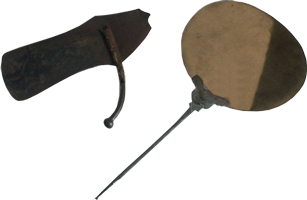
The history of hair removal: from ancient depilation to laser hair removal today
The history of hair removal from hair removal in ancient times to modern laser hair removal today.
Hair removal in prehistoric times
Epilation(from French epiler- "remove hair") - a method of permanent hair removal, when the hair follicle is destroyed by physical or chemical means and after the procedure, hair growth stops forever.

Oddly enough it sounds, but already cavemen used tools for depilation. Ancient people used shellfish to remove unwanted hair. They were used as tweezers, grabbing the hair with sharp and perfectly fitting edges. Thus, it was convenient to pull out the hairs. A silicon scraper with a sharp razor blade was used to cut hair. Therefore, the history of hair removal can be traced back to ancient times.
4000- 3000 BC. They practiced removing unwanted hair using a prototype of modern shugaring - hair removal with a thick sugar syrup, known today as depilation (from the Latin for "complete hair removal").
More than 3000 years ago, a razor and a mirror were an indispensable attribute of a well-to-do person. The social norms of ancient Egypt obliged women to remove unwanted hair from their bodies. The unbearable heat forced the Egyptians to remove hair from the head of men as well as women. During the excavation, razors for hair removal are found.
Depilationis a method of temporary hair removal from the skin surface: shaving, wax depilation, hair pulling, etc. After a while, hair growth will resume.

The Greeks believed that clean-shaven skin was a sign of a civilized person. Fire was used for depilation.
The first shave in Rome was carried out by boys with the onset of maturity. Julius Caesar removed unwanted facial hair by pulling.
Thread Depilation
The technique of removing unwanted hair by pulling came from the Arab countries. For this, two intertwined threads were used, which were pulled over the fingers and quickly shifted them relative to one another. The threads grabbed the hair rising above the surface of the skin and quickly pulled it out.

XV century

Elizabeth I gave impetus to the development of the culture of facial hair depilation. In order to have a high forehead, women plucked hair from their foreheads during the time of Elizabeth I in the middle of the 15th century. Mothers used various compresses to prevent hair growth on the forehead in their children.
XVIII century
At the beginning of the 18th century, a paste made of lime, a caustic substance made from limestone or shell rock, was used to prepare depilatory products at home. When mixed with water, it forms a caustic mixture that burns out hair.
In the 1700s, women in North America used caustic soda to burn off hair. Native Americans, on the other hand, removed their hair by pulling it out one by one using two sinks, as described above. A notable genetic trait of the Indians is that they do not have facial hair.
The first safety razor
A safety razor was patented by a French cutter in 1762.
Depilatory Powder
In the USA, in 1844, the first powder depilatory products went on sale. The boom in piston depilatory products came in the 1920s at the height of advertising campaigns accompanying advertisements for open clothing.
First methods of hair removal
Sulfuric acid
For this at the end of the 9th century in bows the hair was injected with sulfuric acid with a fine needle. This technique led to permanent cessation of hair growth, but did not gain widespread use due to pain and a high risk of scarring.
Electrolysis - a breakthrough in hair removal
Electrolysis was first used in 1875 to remove problematic growing eyelashes and in the 90s it became one of the safest methods of hair removal. The widespread success of this technique was hampered by the long duration and painfulness of the procedure.
Revolution in depilation - disposable blades
In 1903, disposable blades were introduced, making shaving easier and more popular.
Leg hair removal boom in the 20s

The trend of the 20s of the last century was the removal of hair on the legs and in the armpits. This was due to new trends in fashion for clothes with bare shoulders and legs.
Harper's Bazaar in 1914 published the first advertising article on hair removal on legs and arms. In 1915, the same publication launched the first advertising campaign to remove unwanted armpit hair with the Milady Décolleté Gillette women's safe machine. One of the prerequisites for the visualization of the campaign was the demonstration of the beauty of open arms and clean-shaven armpits.
The first epilation machines
With the development of science and technology, the first devices for permanent removal of unwanted hair - epilation - began to appear. The American Tricho System used X-rays for hair removal, acne and other dermatological problems. The technique has been gaining popularity since 1910.
In 1925, X-ray hair removal was awarded a gold medal in Paris.

The epilation procedure lasted only 4 minutes with repeated sessions once a week for several months. The course was stopped when a complete cessation of hair growth was achieved. Skin ulceration, wrinkles, skin cancer, etc. were common complications. Hair removal salons were opened in Europe, Canada and the USA. Due to the large number of side effects, this technique was banned in the United States in the 40s.
Electric Shavers
1931 gave the world an electric shaver.
In the 40s, innovations such as abrasive depilation appeared, similar to modern microdermabrasion.
50th Twizers
In the late 50s, tweeters appeared that automatically pulled out hairs. This was a breakthrough in depilatory techniques as, compared to shaving, plucking with a tweezer had a longer lasting effect of stopping hair growth. Which was a big advantage over shaving.
60s Wax depilation appeared
Based on the sugaring technique, wax depilation appeared.
70s Disposable Machines
The world's first disposable shaving machine for women is born.
80s hot wax
Hot wax depilation appeared in Australia as a modified variation of sugaring.
Laser Hair Removal
The first operational laser was designed in 1961 by Theodore Maiman. Leon Goldman pioneered the use of the ruby laser for tattoo removal. He noticed that the hair at the site of tattoo removal stops growing.
In 1964, the FDA approved a neodymium laser for laser hair removal. The first lasers for hair removal had insufficient power, so a large number of procedures were required for several years before hair growth stopped. Some progress was made in 1983, when lasers with controlled pulse duration appeared, which made the effect on the hair more selective than the surrounding tissues. The explosive growth of laser hair removal technology began in the 90s, when the first diode lasers for hair removal and IPL systems for photoepilation appeared.
Home photoepilators
Technology has gone so far that anyone can purchase a compact IPL system for home hair removal.
Home Hair Removal Laser
The first Tria Laser 4x home laser went on sale in Japan in 2005. FDA approved the first home laser in the United States in 2008.

Home photoepilators and lasers cannot develop enough power for high-quality procedures for all types of skin and hair.
Modern lasers for hair removal
Our clinic uses a Leaseir diode laser capable of developing an output power of up to 6000 W, which is an absolute record. High power ensures the quality and speed of the procedure, and the cooling of the sapphire crystal to 0 ° C guarantees the safety and comfort of the procedure.
More details in the section "Laser hair removal"







